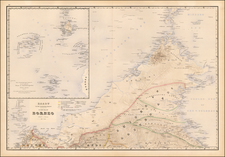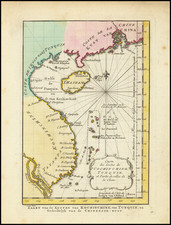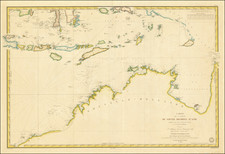Detailed plan of the area around Batavia, including a small area southeast of the town plan which is named Jacarta.
The plan of the area around Batavia, known today as Jakarta, provides an intriguing and detailed look at a then relatively small inhabited area. It meticulously outlines various features including canals, gardens, and fields of sugar cane and rice, all of which give insights into the economic and cultural life of the region.
One of the map's key features is its depiction of a system of canals. These canals were not just a means of transportation but also an essential part of the irrigation system that sustained the fields. The gardens, likely influenced by Dutch horticultural practices, were another essential aspect of the local landscape. These gardens were not merely aesthetic features but also an essential part of the agricultural and trade activities of the city.
Fields of sugar cane and rice are also highlighted in the plan, giving a glimpse into the main agricultural products of the region. Sugar cane, in particular, was a lucrative crop and a significant export, while rice was a staple food and a vital part of the local diet. Their inclusion in the plan speaks to their importance in both the local economy and the broader colonial trade network.
Notably, the map also identifies a small outlying fortification named "Jacatra," upriver from the main part of Batavia. Along with Vyscheck and Ankee, which are shown on a canal southwest of Batavia, these fortifications were likely vital to the defense and control of the area. The inclusion of these structures in the plan reflects the military considerations of the time and the complex interaction between colonial security and local dynamics.
Jakob van der Schley was a skilled draftsman and engraver who operated out of Amsterdam and had strong ties with the Hague. He was trained by Bernard Picart and his style resembles that of the elder man. Van der Schely was known for intricately engraved portraits and frontispieces. He signed most of the plates used in the Hague edition of the Abbe Prevost's Histoire generale des voyages.










![Tabula Asiae XI [India and Southeast Asia]](https://storage.googleapis.com/raremaps/img/small/94323.jpg)


![Belgium Foederatum auctius et emendatius… [Large inset of SE Asia]](https://storage.googleapis.com/raremaps/img/small/89316.jpg)
![[ Lhasa, Tibet ] Bietala](https://storage.googleapis.com/raremaps/img/small/97334.jpg)